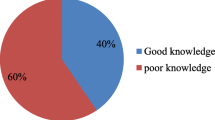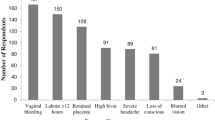Abstract
Background
High numbers of maternal mortality rate and child mortality rate continue to be the pressing issues in Indonesia. To tackle this problem, multiple approaches have been undertaken, particularly through distributing a Maternal and Child Health (MCH) handbook to every pregnant woman. However, despite the widespread usage of such handbook, its true efficacy in supporting safe motherhood by improving maternal knowledge on various stages of pregnancy and the associated obstetric danger signs is relatively unknown and remains to be established.
Methods
This is a primary cross-sectional study conducted at Majalengka General District Hospital on recently delivering postpartum women between August and September 2017. A total of 127 women were recruited and later divided into two separate groups according to their self-admission on the degree they had read the MCH handbook (≥ 50% and < 50%) and administered a pre-validated questionnaire to assess their knowledge around pregnancy and its danger signs.
Results
We discovered that our population had high knowledge around pregnancy and its danger signs, and the MCH handbook did not hold a significant role in effecting this finding (p value 0.295). Furthermore, various sociodemographic factors (age, educational backgrounds, welfare status, distance from healthcare center, parity and number of ANC visits) also did not exert a statistically significant influence on the level of knowledge in our population (p values 0.579, 0.521, 0.617, 0.908, 0.342, 0.618 and 0.939 respectively).
Conclusion
To conclude, the MCH handbook did not exert a significant influence in improving maternal knowledge levels around pregnancy and the associated obstetric danger signs.
Similar content being viewed by others
References
(BPS) SI, (BKKBN) NPaFPB, Ministry of Health RoIK-M, International I. Indonesia Demographic and Health Survey 2012. Jakarta: 2013.
UNICEF. Maternal and child health. Jakarta: UNICEF; 2012. https://www.unicef.org/indonesia/A5-_E_Issue_Brief_Maternal_REV.pdf.
Bhuiyan SU, Nakamura Y. Continuity of maternal, neonatal and child health care through MCH handbook for ensuring the quality of life. Child Research; 2009 [updated January 1, 2009; cited 2017 17 July].
Indonesia MoHRo. Buku Kesehatan Ibu dan Anak. Jakarta: Ministry of Health, Republic of Indonesia, Japan International Cooperation Agency; 2016.
Nakamura Y. Is Maternal and Child Health Handbook effective? Meta-analysis of the effects of MCH handbook. Kokusai Hoken Iryo (J Int Health). 2012;27(2):121–7.
Osaki K, Hattori T, Kosen S. The role of home-based records in the establishment of a continuum of care for mothers, newborns, and children in Indonesia. Glob Health Action. 2013;6:1–12.
Kusumayati A, Nakamura Y. Increased utilization of maternal health services by mothers using the Maternal and Child Health Handbook in Indonesia. Kokusai Hoken Iryo (J Int Health). 2007;22(3):143–51.
Brown HC, Smith HJ, Mori R, Noma H. Giving women their own case notes to carry during pregnancy. Cochrane Database Syst Rev. 2015. https://doi.org/10.1002/14651858.CD002856.pub3.
Dawson B, Trapp RG. Research questions about two separate or independent groups. In: Foltin J, Lebowitz H, Fernando N, editors. Basic & clinical biostatistics. New York: McGraw Hill Medical; 2004. p. 134–61.
Cunningham FG, Leveno KJ, Bloom S, et al. Preconceptional counseling. Williams obstetrics. 23rd ed. New York: McGraw Hill Medical; 2010. p. 174–88.
Gupta R, Shora T, Verma A, et al. Knowledge regarding antenatal care services, its utilization, and delivery practices in mothers (aged 15–49 years) in a rural area of North India. Trop J Med Res. 2015;18(2):89–94.
Nithya R, Dorairajan G, Chinnakali P. Do pregnant women know about danger signs of pregnancy and childbirth? A study of the level of knowledge and its associated factors from a tertiary care hospital in Southern India. Int J Adv Med Health Res. 2017;4(1):11–7.
Okour A, Alkhateeb M, Amarin Z. Awareness of danger signs and symptoms of pregnancy complication among women in Jordan. Int J Gynaecol Obstet. 2012;118(1):11–4.
Hailu D, Berhe H. Knowledge about obstetric danger signs and associated factors among mothers in Tsegedie District, Tigray Region, Ethiopia 2013: community based cross-sectional study. PLoS ONE. 2014;9(2):e83459.
Bililign N, Mulatu T. Knowledge of obstetric danger signs and associated factors among reproductive age women in Raya Kobo district of Ethiopia: a community based cross-sectional study. BMC Pregnancy Childbirth. 2017;17(1):70.
Bogale D, Markos D. Knowledge of obstetric danger signs among child bearing age women in Goba district, Ethiopia: a cross-sectional study. BMC Pregnancy Childbirth. 2015;15:77.
Ambike D, Ambike A, Raje S, et al. Knowledge, awareness and breast-feeding practices of postnatal mothers in a rural teaching hospital: a cross sectional survey. Int J Reprod Contracept Obstet Gynecol. 2017;6(12):5429–34.
Agunwa C, Nnebue CC, Duru CB, et al. Knowledge of obstetric danger signs among women of reproductive age in rural communities in Enugu State, Nigeria. Am J Health Res. 2015;3(6):376–80.
Kabakyenga JK, Östergren P-O, Turyakira E, et al. Knowledge of obstetric danger signs and birth preparedness practices among women in rural Uganda. Reprod Health. 2011;8(1):33.
Sood S, Sengupta M, Shefner-Rogers CL, et al. Impact of the SIAGA maternal and neonatal communication campaign on knowledge of danger signs and birth preparedness in West Java, Indonesia. J Health Mass Commun. 2009;1(1/2):40–57.
Pandara VE. Utilization of MCH handbook and exclusive breastfeeding among mothers of children 6 to 12 months old in Manado, Indonesia. Salaya: Mahidol University; 2006.
Hagiwara A, Ueyama M, Ramlawi A, et al. Is the Maternal and Child Health (MCH) handbook effective in improving health-related behavior? Evidence from Palestine. J Public Health Policy. 2013;34(1):31–45.
Acknowledgements
We would like to thank Dr. Lulu Eva Rakhmalia, MKM for her valuable critique and scholarly input and Dr. Wing Wiryawan, SpOG for his support throughout the study.
Author information
Authors and Affiliations
Corresponding author
Ethics declarations
Conflict of interest
Kevin Dominique Tjandraprawira and Ivan Ghozali declare that they do not have any conflicts of interest to disclose.
Ethical Approval
This study received ethical approval from both Majalengka district and hospital’s ethics review boards.
Additional information
Dr. Kevin Dominique Tjandraprawira, Ivan Ghozali, General Physician, Department of Obstetrics and Gynecology, Majalengka General District Hospital (Rumah Sakit Umum Daerah Majalengka).
Rights and permissions
About this article
Cite this article
Tjandraprawira, K.D., Ghozali, I. Knowledge of Pregnancy and Its Danger Signs Not Improved by Maternal and Child Health Handbook. J Obstet Gynecol India 69, 218–224 (2019). https://doi.org/10.1007/s13224-018-1162-0
Received:
Accepted:
Published:
Issue Date:
DOI: https://doi.org/10.1007/s13224-018-1162-0




